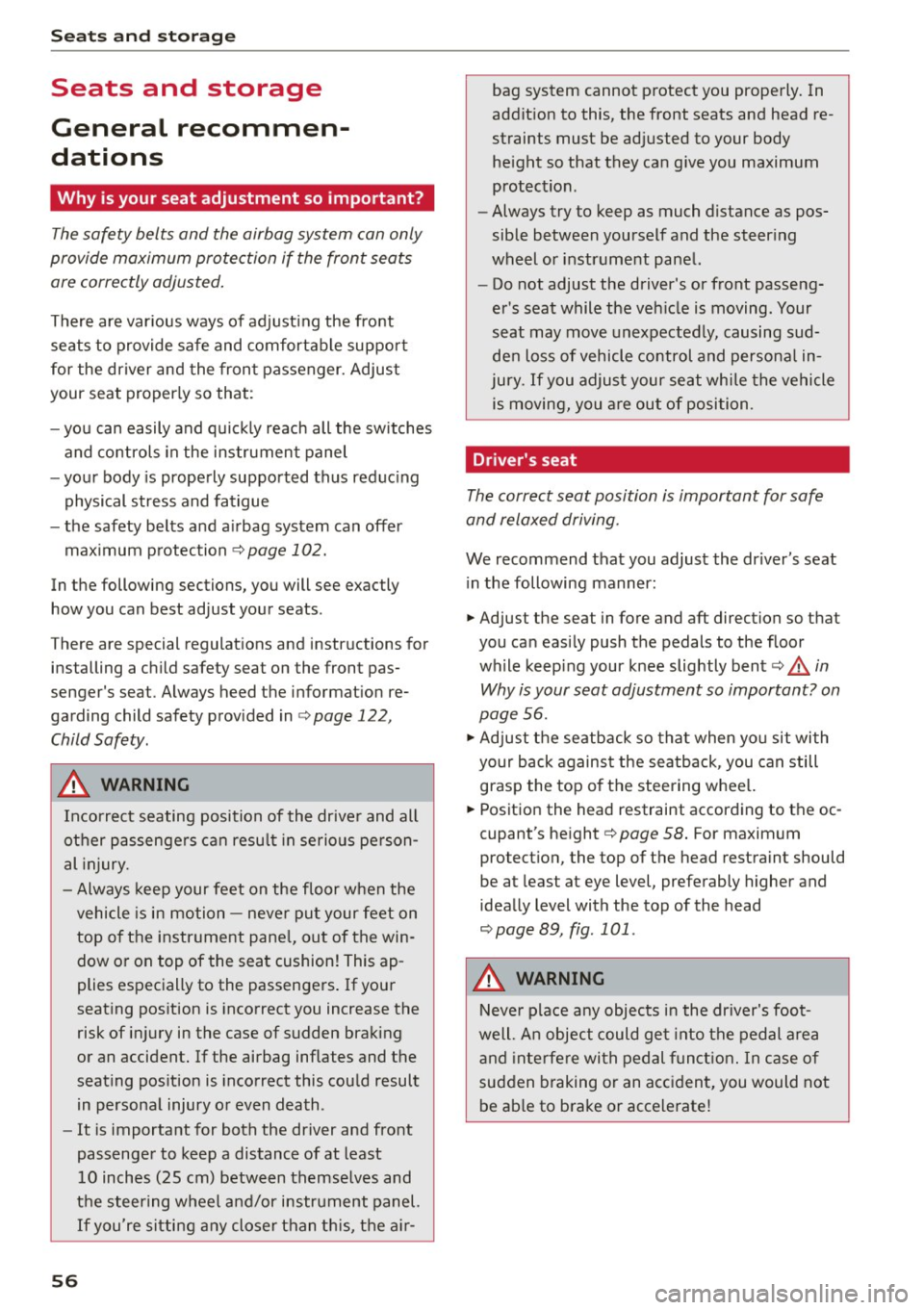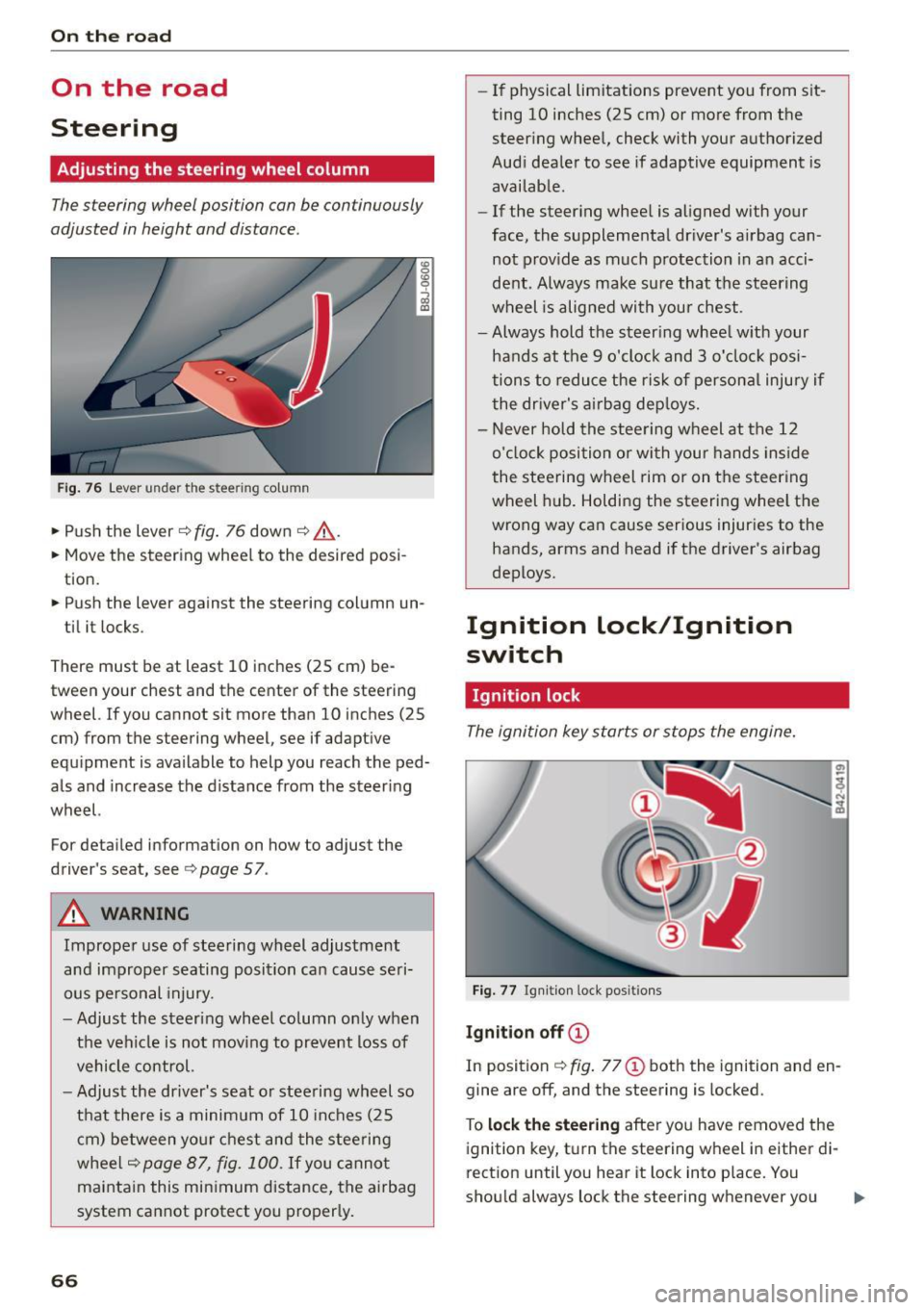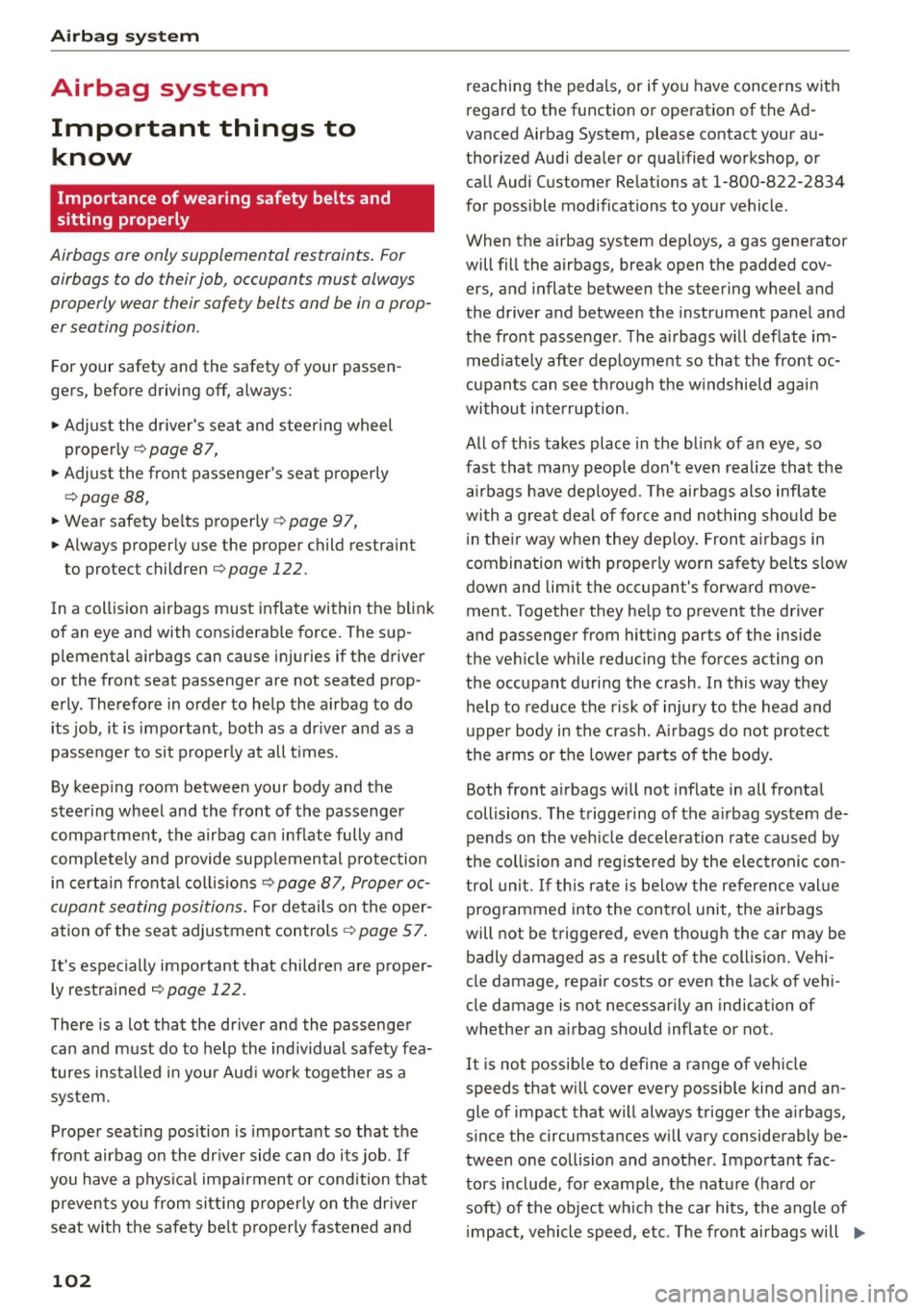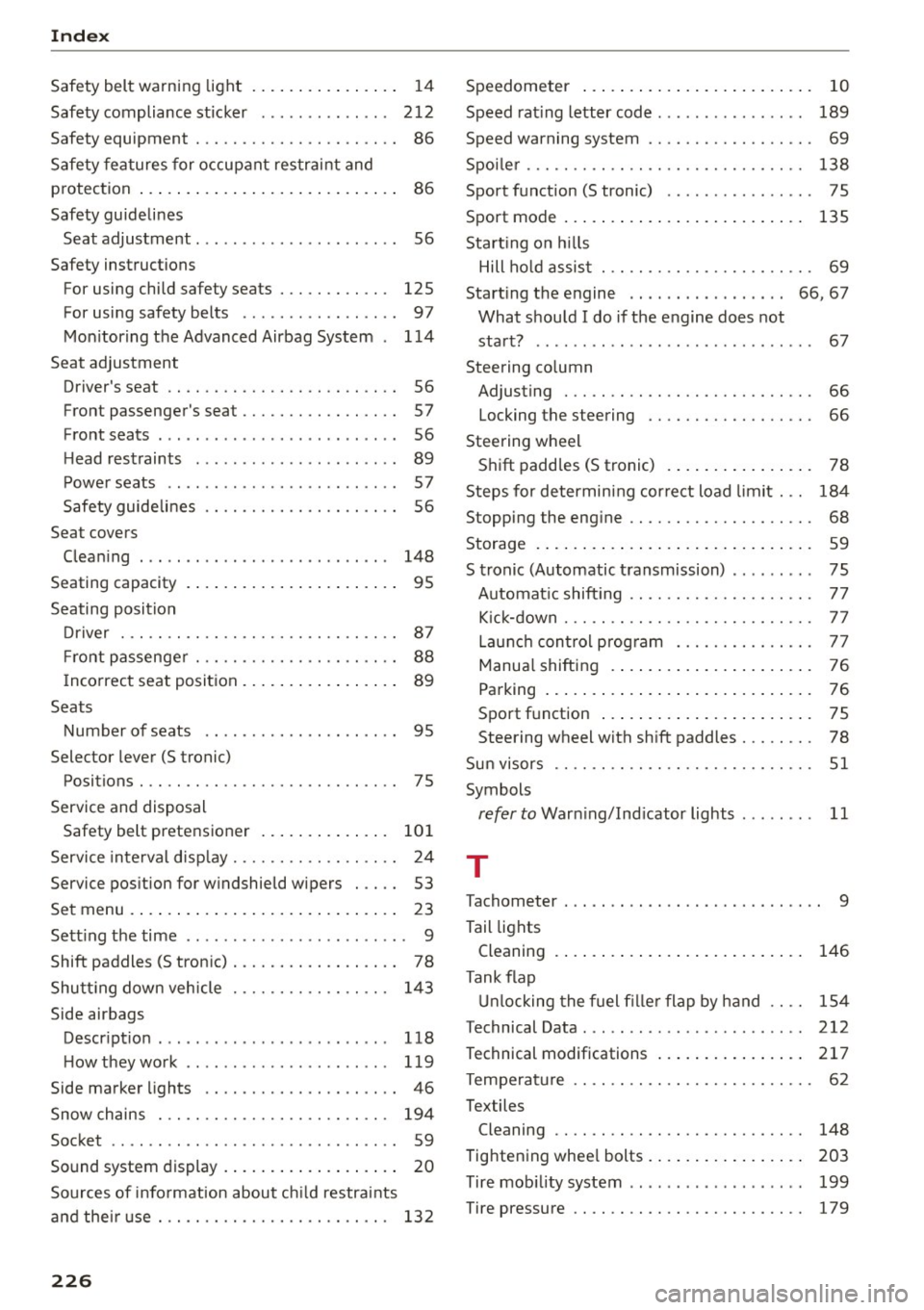steering wheel adjustment AUDI R8 SPYDER 2015 Owners Manual
[x] Cancel search | Manufacturer: AUDI, Model Year: 2015, Model line: R8 SPYDER, Model: AUDI R8 SPYDER 2015Pages: 232, PDF Size: 58.36 MB
Page 58 of 232

Seat s and storage
Seats and storage
General recommen
dations
Why is your seat adjustment so important?
The safety belts and the airbag system can only
provide maximum protection if the front seats are correctly adjusted.
There are var ious ways of adjust ing the front
seats to provide safe and comfortable suppo rt
for the driver and the front passenger. Adjust
your seat properly so that :
- you can easily and quick ly reach all the switches
and controls in the instrument panel
- your body is prope rly supported thus reduc ing
physical stress and fatigue
- the safety belts and a irbag system can offer
maximum p rotection
<> page 102.
In the following sections, you will see exactly
how you can best ad just your seats .
There are special regulat ions and inst ructions for
installing a c hild safety seat on the front pas
senger 's seat . Always heed the informat ion re
garding child safety prov ided in<>
page 122 ,
Child Safety.
_& WARNING
Incorrect seating position of the drive r and all
other passenge rs can resu lt in serious pe rson
al injury.
- Always keep your feet on the floor when the
vehicle is in m otion -neve r put your feet on
top of the instrument pane l, out of the win
dow or on top of the sea t cushion! This ap
plies es pecially to the passenge rs . If you r
seat ing pos ition is incorrect you increase the
risk of injury in the case of sudden bra king
or an accident. If the airbag inflates and the
seat ing pos ition is incorrect this cou ld result
in persona l injury o r even dea th .
- It is important for both the driver and front
passenge r to keep a distance of at least
10 inches (25 cm) between themselves and
t h e steering wheel and/or instrument panel.
If you're sitting any closer than th is, t he a ir-
56
bag system cannot p rotect you properly. In
addit ion to this, the front seats and head re
straints must be adjusted to your body he ight so that they can g ive you maximum
protection.
- Always try to keep as much distance as pos
sible between yourself and the steer ing
wheel or instrument pane l.
- Do not adjust the driver's or front passeng
er's seat while the veh icle is moving . Your
seat may move unexpected ly, causing sud
den loss of vehicle control and persona l in
jury.
If you adju st your seat while the vehicle
is moving, you are out of position .
Driver's seat
The correct seat position is important for safe
and rela xed driving .
We recommend that you adjust the dr iver's seat
i n the following manner:
.,. Adjust the seat in fore and aft direction so t hat
you ca n eas ily push the pedals to the floor
wh ile keep ing your knee slightly bent¢.&.
in
Why is your seat adjustment so important? on
page 56.
.,. Adjust the se atb ack so tha t when yo u sit wi th
your back agains t the sea tback, you ca n still
grasp the top of the steering whee l.
.,. Posit ion the head restraint according to the oc
cupant's he ight ¢
page 58. For maximum
protect ion, the top of the head restraint should
be at least at eye level, preferably higher and
idea lly level with the top of the head
¢ page 89, fig . 101 .
_& WARNING
Neve r place any objects in the dr iver's foo t
well. An object could ge t into t he pedal are a
a nd in te rfere wi th pedal fun ct ion . In case o f
sud den braking or an acc ident, you wou ld not
be ab le to b rake or accele rate!
-
Page 68 of 232

On the road
On the road
Steering
Adjusting the steering wheel column
The steering wheel position can be continuously
adjusted in height and distance .
Fig. 76 Lever u nde r the stee rin g co lumn
... Push the lever ¢ fig. 76 down ¢ _&.. .
... Move the steering wheel to the desired posi
tion .
... Push the lever against the steering column un-
til it locks .
There must be at least 10 inches (25 cm) be
tween your chest and the center of the steering
wheel. If you cannot sit more than 10 inches (25
cm) from the steering wheel, see if adaptive
equipment is ava ilable to help you reach the ped
als and increase the distance from the steering
wheel.
For detailed information on how to adjust the
driver's seat, see
¢ page 57.
A WARNING
Improper use of steering wheel adjustment
and improper seating position can cause seri
ous pe rsonal injury.
- Adjust the steering wheel column only when
the vehicle is not moving to prevent loss of
vehicle control.
- Adjust the driver's seat or stee ring wheel so
that there is a minimum of 10 inches (25
cm) between your chest and the steering
wheel¢
page 87, fig. 100. If you cannot
maintain this min imum distance, the airbag
system cannot protect you proper ly.
66
- If physical limitations prevent you from sit
ting 10 inches (25 cm) or more from the steering wheel, check with your authorized
Audi dealer to see if adaptive equipment is
available.
- If the steering wheel is aligned with your
face, the supplemental dr iver's airbag can
not p rov ide as much protection in an acci
dent. Always make sure that the steering
wheel is aligned with your chest.
- Always hold the steering wheel w ith your
hands at the 9 o'clock and 3 o'clock posi
tions to reduce the risk of persona l injury if
the dr iver's airbag dep loys.
- Never hold the steering wheel at the 12 o'clock position or with your hands inside
the steering wheel rim or on the steering
wheel h ub. Holding the steering wheel the
wrong way can cause serious injuries to the hands, arms and head if the driver's airbag
deploys.
Ignition Lock/Ignition
switch
Ignition lock
The ignition key starts or stops the engine.
Fig. 77 Ign it ion lock posit ions
Ignit ion off CD
In position ¢ fig. 77 (D both the ignition and en
gine are off, and the steering is locked.
To
l ock the steering after you have removed the
ignition key, t urn the steering wheel in either di
rection until you hear it lock into place. You
should always lock the steering whenever you .,.
Page 104 of 232

Airbag syste m
Airbag system
Important things to know
Importance of wearing safety belts and
sitting properly
Airbags are only supplemental restraints . For
airbags to do their job , occupants must always
properly wear their safety belts and be in a prop
er seating position.
For your safety and the safety of your passen
gers, before driving off, always:
.,. Adjust the dr iver's seat and steering wheel
proper ly ¢
page 87,
.,. Adjust the front passenger's seat properly
¢ page 88,
.,. Wear safety be lts proper ly ¢ page 9 7,
.,. Always properly use the proper child restra int
to protect children ¢
page 122.
In a collision airbags must inflate within the b link
of an eye and with cons iderable force. The sup
plemental a irbags can cause injuries if the driver
or the front seat passenger are not seated prop
erly . Therefore in order to help the airbag to do
its job, it is important, both as a dr iver and as a
passenger to sit properly at all times.
By keep ing room between your body and the
steer ing wheel and the front of the passenger
compartment, the airbag can inflate fully and
comp lete ly and provide supp lemental p rotec tion
in certa in fronta l co llisions ¢
page 87, Proper oc
cupant seating positions . For details on the oper
ation of the seat adjustment controls¢
page 57.
It's especially important t hat childre n are p roper
ly res trained
¢ page 122.
There is a lot that the driver and the passenger
can and must do to help the ind iv idual safety fea
tures insta lled i n your Aud i work together as a
system.
Proper seat ing pos ition is important so that t he
front airbag on the dr iver side can do its job . If
you have a p hys ica l impairment o r condition that
p revents you from sitt ing p roperly on the driver
seat with the safety be lt properly fastened and
102
reaching the pedals, or if you have concerns with
regard to the function or operatio n of the Ad
vanced Airbag System, please contact your a u
thori zed Audi dea ler or qua lified workshop, or
call Audi Customer Re lations at 1-800-822-2834
for poss ible modifications to your vehicle .
When the airbag system dep loys, a gas generator
will fill the airbags, break open the padded cov ers, and inflate between the steering wheel and
the driver and between the instrument panel and
the front passenger . Th e airbags w ill deflate im
med iate ly after deployment so that the front oc
cupants can see t hrough the w indshield aga in
without i nte rruption .
All of th is takes place in the blink of an eye , so
fast that many people don't even realize that the
a irbags have deployed. The airbags also inflate
with a grea t deal of force and nothing sho uld be
i n the ir way when they dep loy. Front a irbags in
combination with properly worn safety belts s low
down and limit the occ upant's forward move
ment . T ogether they he lp to prevent the driver
and passenger from hitt ing parts of the inside
the ve hicle while reducing the forces ac ting on
the occupant during the crash . In this way they
help to reduce the risk of injury to the head and
upper body in the crash. A irbags do not protect
the arms o r the lowe r parts of the body.
Both front a irbags w ill not inflate in all fronta l
collisions. The t rigge ring of the a irbag system de
pends on the veh icle deceleration rate caused by
the coll is ion a nd registe red by the elec tronic con
trol uni t. If th is rate is below the reference val ue
programmed into the contro l unit , the airbags
will not be t rigge red , even thoug h the car may be
badly damaged as a result of t he collisio n. Vehi
cle damage, repair costs or even the lack of vehi
cle damage is not necessarily an indication of
whether an a irbag should infla te or not .
It is not possib le to define a range of vehicle
speeds that w ill cover every possib le kind and an
gle of impact that will always trigger the a irbags,
s ince the circums tances w ill vary considerably be
tween one collision and another . Important fac
tors include, for example, the natu re (ha rd or
soft) of the object wh ic h the car hits, the angle of
i mpact, vehicle speed , etc. The front airbag s will .,.
Page 228 of 232

Index
Safety belt warning light . . . . . . . . . . . . . . . . 1 4
Safety compliance sticker . . . . . . . . . . . . . . 212
Safety equipment . . . . . . . . . . . . . . . . . . . . . . 86
Safety fea tures for occup ant res tra in t and
protec tion . . . . . . . . . . . . . . . . . . . . . . . . . . . . 86
Safety guideli nes
Seat adjustment . . . . . . . . . . . . . . . . . . . . . . 56
Safety instructions
For using child safety seats . . . . . . . . . . . . 125
For using safety belts . . . . . . . . . . . . . . . . . 97
Mon itor ing t he Advanced Airbag System 114
Seat adjustment Driver's seat . . . . . . . . . . . . . . . . . . . . . . . . . 56
Front passenger 's seat.. . . . . . . . . . . . . . . . 57
Front seats . . . . . . . . . . . . . . . . . . . . . . . . . . 56
H ead r estr aints . . . . . . . . . . . . . . . . . . . . . . 89
P owe r seats .................. ... .. .. 57
Safety guideli nes . . . . . . . . . . . . . . . . . . . . . 56
Seat covers
Clea ning . . . . . . . . . . . . . . . . . . . . . . . . . . . 148
Seating capacity . . . . . . . . . . . . . . . . . . . . . . . 95
Seating position Driver . . . . . . . . . . . . . . . . . . . . . . . . . . . . . . 87
Fr ont p assenge r . . . . . . . . . . . . . . . . . . . . . . 8 8
I ncorrect seat posit ion . . . . . . . . . . . . . . . . . 89
Seats Number of seats . . . . . . . . . . . . . . . . . . . . . 9S
Selector lever (S tronic)
Pos1t1ons . . . . . . . . . . . . . . . . . . . . . . . . . . . . 7 5
Service and disposal Safety belt pretensioner . . . . . . . . . . . . . . 10 1
Service inte rval d isp lay . . . . . . . . . . . . . . . . . . 2 4
Service pos ition for w indshield wipers . . . . . 53
Se t menu. ..... .. ... .. ..... ... .. .. .... 23
Se tt ing the time . . . . . . . . . . . . . . . . . . . . . . . . 9
Shift paddles (S tronic) . . . . . . . . . . . . . . . . . . 78
Shutt ing down vehicle . . . . . . . . . . . . . . . . . 143
Side airbags
Descript io n . . . . . . . . . . . . . . . . . . . . . . . . . 118
H ow they work .. .............. .... .. 119
Side marker lights . . . . . . . . . . . . . . . . . . . . . 46
Snow ch ains . . . . . . . . . . . . . . . . . . . . . . . . . 194
Socket . . . . . . . . . . . . . . . . . . . . . . . . . . . . . . . 59
So und system display . . . . . . . . . . . . . . . . . . . 20
Sources of info rmat ion about c hild restra ints
a nd the ir use . . . . . . . . . . . . . . . . . . . . . . . . . 132
226
Speedometer . . . . . . . . . . . . . . . . . . . . . . . . . 10
Speed rat ing letter code . . . . . . . . . . . . . . . . 189
Speed warning system . . . . . . . . . . . . . . . . . . 69
Spoi le r . . . . . . . . . . . . . . . . . . . . . . . . . . . . . . 138
Sport function (S tronic) . . . . . . . . . . . . . . . . 75
Sport mode . . . . . . . . . . . . . . . . . . . . . . . . . . 135
Start ing o n hill s
Hill ho ld assis t . . . . . . . . . . . . . . . . . . . . . . . 69
Start ing the engine . . . . . . . . . . . . . . . . . 66, 67
What should I do if t he engine does not
start? . . . . . . . . . . . . . . . . . . . . . . . . . . . . . . 67
Steering co lumn
Adjust ing . . . . . . . . . . . . . . . . . . . . . . . . . . . 66
Locking the steering . . . . . . . . . . . . . . . . . . 66
Steering wheel Shift padd les (5 tronic) . . . . . . . . . . . . . . . . 78
Steps for determin ing corre ct load limit . . . 184
Stopping the engine . . . . . . . . . . . . . . . . . . . . 68
Storage . . . . . . . . . . . . . . . . . . . . . . . . . . . . . . 59
5 tronic (Automatic transmission) . . . . . . . . . 75
Automat ic shift ing . . . . . . . . . . . . . . . . . . . . 77
Ki ck-down . . . . . . . . . . . . . . . . . . . . . . . . . . . 77
La un ch con trol prog ram . . . . . . . . . . . . . . . 77
Manua l shifting . . . . . . . . . . . . . . . . . . . . . . 76
Pa rking . . . . . . . . . . . . . . . . . . . . . . . . . . . . . 76
Sport fu nction . . . . . . . . . . . . . . . . . . . . . . . 75
Steering wheel with shift paddles . . . . . . . . 78
Su n visors . . . . . . . . . . . . . . . . . . . . . . . . . . . . 51
Symbols
refer to War ning/Ind icator lights . . . . . . . . 11
T
Tachometer . . . . . . . . . . . . . . . . . . . . . . . . . . . . 9
Tail lights Cleaning . . . . . . . . . . . . . . . . . . . . . . . . . . . 146
Tank flap Unl ocking the fuel fill erflapby hand .. .. 15 4
Technical Data . . . . . . . . . . . . . . . . . . . . . . . . 212
Technical modifications . . . . . . . . . . . . . . . . 217
Tempe rat ure . . . . . . . . . . . . . . . . . . . . . . . . . . 62
Textiles Cleaning . . . . . . . . . . . . . . . . . . . . . . . . . . . 148
Tighte ning whee l bolts . . . . . . . . . . . . . . . . . 203
Tire mob ility system . . . . . . . . . . . . . . . . . . . 199
Tire pressure . . . . . . . . . . . . . . . . . . . . . . . . . 179